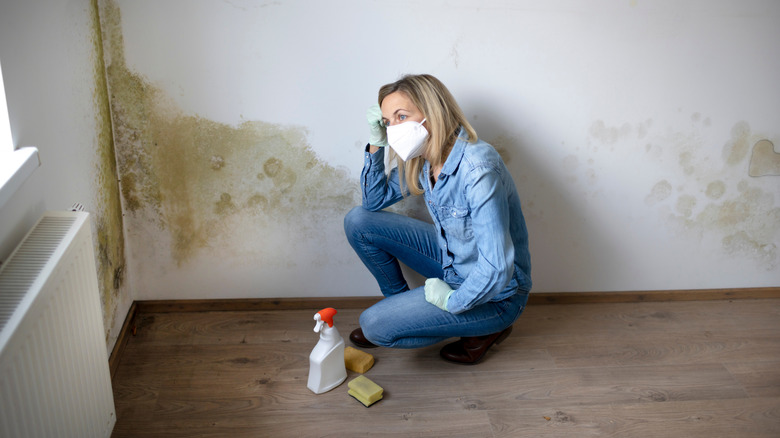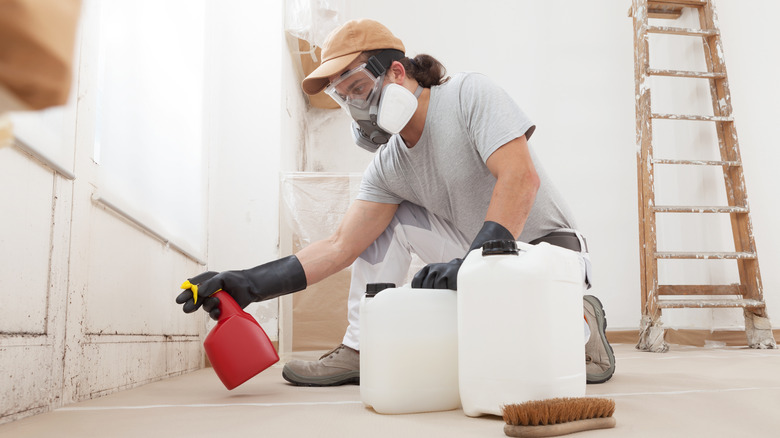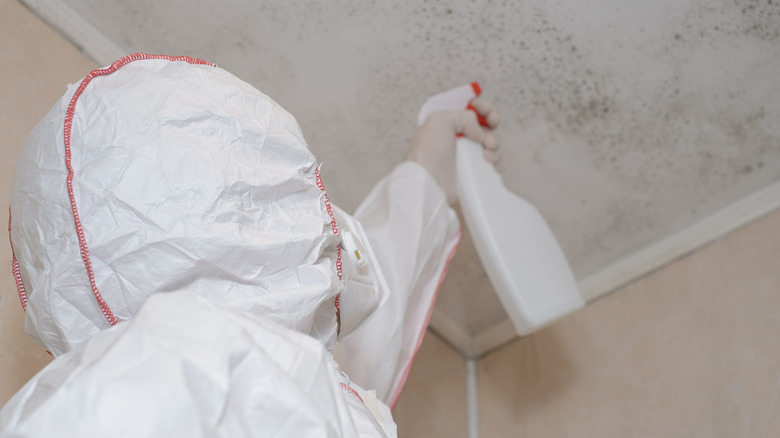Should You Remove Black Mold Yourself Or Call A Professional? Here's What We Know
Completing a house project on your own can be both rewarding and cost-saving. However, there are times when it is best to call a professional. There are easy ways to clean mold, but if you discover black mold in your home, can you remove it yourself, or should you call some professional help? House Digest spoke exclusively with Michael Rubino, mold and air quality expert, environmental wellness advocate, and founder of HomeCleanse to hear his thoughts on this question.
Whether you can remove the black mold by yourself depends on your situation. Rubino suggests that you start with identifying black mold in your home. "Researchers have identified over 100,000 species of mold so far, and they come in various shapes and colors," Rubino said. "Many species, such as Aspergillus and Chaetomium, can appear black. That said, people talking about 'black mold' typically refer to a species called Stachybotrys chartarum, thanks to the media's focus on this particular growth. Testing is the best way to differentiate between different species of mold because many species can be dark in color." You can use an at-home test to get some results, but you will also want to hire a qualified mold inspector.
"A qualified mold inspector will help narrow down whether that one location is the only source and how intense the growth is and provide recommendations on a plan of action to eliminate the issue," Rubino explained. "They should spend at least a few hours combing through the interior and exterior of the home, using various testing methodologies. Do not settle for a single air test in the center of the room."
How to handle mold in your home
Once you know that you have mold in your home, you have to decide how to best handle the situation. In Rubino's exclusive interview with House Digest, he explained that who removes the mold depends on a few factors.
"If the proper steps are taken, homeowners can typically handle anything under 10 square feet," Rubino said. If you decide to do this project on your own, you need to address the source of the issue, take precautions to prevent the spread of mold during the work, remove all microbial growth including roots, dead particles, remove all contamination, including mycotoxins and bacteria, and thoroughly clean the house. "So, for issues such as mold on the ceiling or wall, porous materials, like drywall, must be removed and replaced, and non-porous and semi-porous surfaces must be cleaned appropriately to eliminate contamination," Rubino explained. "This often involves abrasive methodologies for semi-porous surfaces to eliminate the mold roots and then seal, if possible. PPE [Personal Protective Equipment] should also be used, and containment areas should be created to ensure particles do not spread to other areas of the home or enter your body."
For anything more than 10 square feet or if you aren't confident, call a professional. "Professionals should be called to help identify hidden problems that might not be obvious, especially if testing continually shows that DIY remediation efforts are unsuccessful," Rubino said. "Also, call professionals if health is a concern. If you are immunocompromised, you want the job done correctly the first time."
Why black mold is dangerous
Many people know that black mold is dangerous. When House Digest spoke exclusively with Rubino, he explained why it is so important to remove black mold from your home. "All species of mold reproduce by creating microscopic spores and releasing them into the surrounding area," Rubino said. "All mold growth should be eliminated because the byproducts it releases lower our indoor air quality and cause unwanted exposures. Some species of mold, like Stachybotrys chartarum, also release microscopic toxins called mycotoxins when threatened. Exposure to mycotoxins can cause a range of negative health effects."
During Rubino's interview, he explained how mold particles can influence your health. "Once inside, they trigger an immune response," Rubino said. "As the particles continue to enter the body, the immune system will attempt to keep removing them, but it can become overloaded or malfunction. Those who are hypersensitive or who have compromised or developing immune systems are particularly susceptible. This can lead to widespread inflammation and opens the door for chronic symptoms or conditions. As 'black mold' releases mycotoxins, this is why it's considered to be particularly hazardous." Black mold isn't the only type of mold to be worried about, though, as many other types of mold release mycotoxins too. "All mold growth should be eliminated as soon as possible," Rubino said
If you don't have mold in your home, follow these tips to prevent mold from entering your home. However, if you are concerned that you do, and aren't sure how to handle the situation, it is probably best to call a professional.


